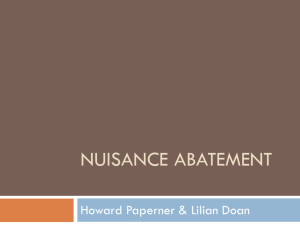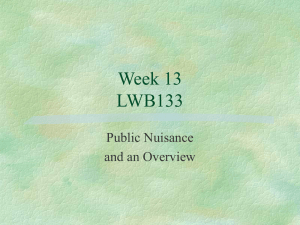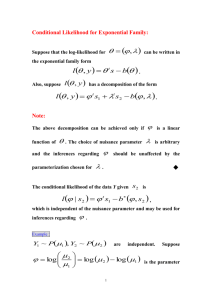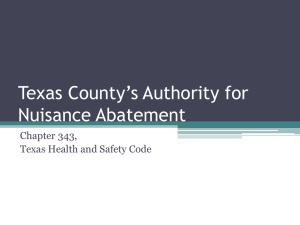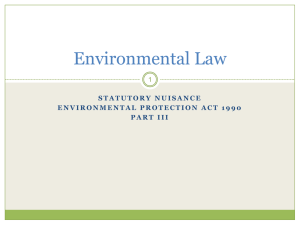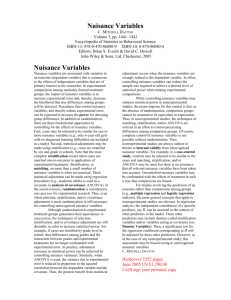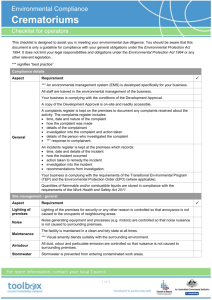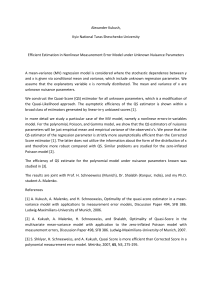GRF_nuisance_ordinance_Dec2014_adopted
advertisement
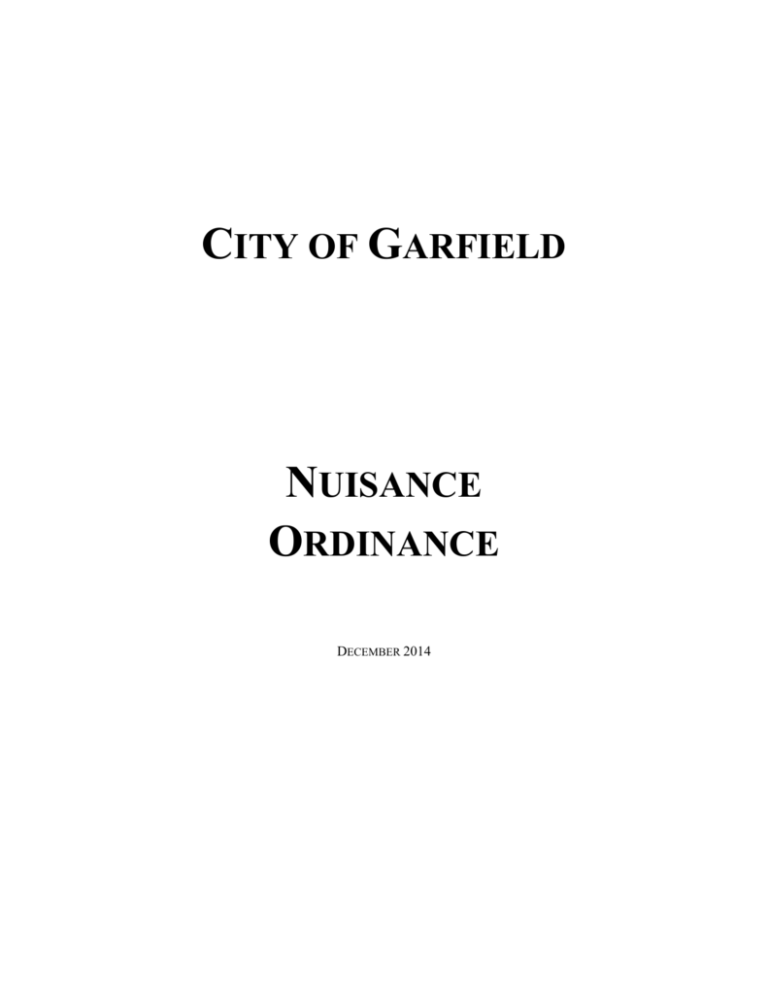
CITY OF GARFIELD NUISANCE ORDINANCE DECEMBER 2014 ORDINANCE NO. ___101_______ AN ORDINANCE REGULATING PUBLIC NUISANCES WITHIN THE CITY OF GARFIELD, MINNESOTA THE CITY COUNCIL OF THE CITY OF GARFIELD, MINNESOTA DOES ORDAIN: SECTION ONE. GENERAL. Properties where nuisance activities occur regularly can be a blight on the whole neighborhood. The nuisances frighten away law abiding residents, discourage reinvestment and consume police and other city services. If a property owner is suffering from a nuisance created by another property owner within the City, the City encourages them to try and resolve the matter informally by speaking to, or writing a letter to the offending property owner about the problem you are experiencing. This approach often has a longer-lasting effect than when City officials become involved. SECTION TWO. PUBLIC NUISANCE PROHIBITION. A person must not act, or fail to act, in a manner that is or causes a public nuisance. For purpose of this ordinance, a person that does any of the following is guilty of maintaining a public nuisance: (A) Maintains or permits a condition which unreasonably annoys, injures, or endangers the safety, health, morals, comfort or repose of any considerable number of members of the public; or (B) Interferes with, obstructs, or renders dangerous for passage, any public highway or right-ofway, or waters used by the public; or (C) Does any other act or omission declared by law or this ordinance to be a public nuisance. SECTION THREE. PUBLIC NUISANCES AFFECTING HEALTH. The following are hereby declared to be nuisances affecting health: (A) The exposed accumulation of decayed or unwholesome food or vegetable matter; (B) All diseased animals running at large; (C) All ponds or pools of stagnant water; (D) Carcasses of animals not buried or destroyed within twenty-four (24) hours after death; (E) Accumulation of manure, refuse, or other debris; (F) Privy vaults and garbage cans which are not rodent-free or fly-tight, or which are so maintained as to constitute a health hazard or to emit foul and disagreeable odors; (G) The pollution of any public well or cistern, stream or lake, canal or body of water by sewage, industrial waste, or other substances; (H) All noxious weeds, grass in excess of ten (10) inches in height, and other rank growths of vegetation upon public or private property one (1) acre or less in size; (I) Dense smoke, noxious fumes, gas, soot, or cinders in unreasonable quantities; (J) All public exposure of people having a contagious disease; and (K) Any offensive trade or business as defined by statute not operating under local license. 1 City of Garfield Nuisance Ordinance – December 2014 SECTION FOUR. PUBLIC NUISANCES AFFECTING MORALS AND DECENCY. The following are hereby declared to be nuisances affecting public morals and decency: (A) All gambling devices, slot machines, and punch boards, except otherwise authorized and permitted by federal, state, or local law; (B) Betting, bookmaking, and all apparatus used in those occupations; (C) All houses kept for the purpose of prostitution or promiscuous sexual intercourse, gambling houses, houses of ill fame, and bawdy houses; (D) All places where intoxicating or 3.2 malt liquor is manufactured or disposed of in violation of law or where, in violation of law, people are permitted to resort, for the purpose of drinking intoxicating or 3.2 malt liquor, or where intoxicating or 3.2 malt liquor is kept for sale or other disposition in violation of law, and all liquor and other property used for maintaining that place; and (E) Any vehicle used for the unlawful transportation of intoxicating or 3.2 malt liquor, or for promiscuous sexual intercourse, or any other immoral or illegal purpose. SECTION FIVE. PUBLIC NUISANCES AFFECTING PEACE AND SAFETY. The following are declared to be nuisances affecting public peace and safety: (A) All snow and ice that is not removed from public sidewalks within forty-eight (48) hours after the snow or other precipitation causing the condition has ceased to fall; (B) All trees, hedges, billboards, or other obstructions which prevent people from having a clear view of all traffic approaching an intersection; (C) All wires and limbs of trees that are so close to the surface of a sidewalk or street as to constitute a danger to pedestrians or vehicles; (D) Any person participating in any party or other gathering that causes the unreasonable disturbing of the peace, quiet, or repose of another person; (E) All unnecessary and annoying vibrations; (F) Obstructions and excavations affecting the ordinary maintenance or public use of public rightof-way or easements, streets, alleys, sidewalks, or other public grounds, except under conditions as are permitted by this ordinance or other applicable law; (G) Radio aerials or television antennae erected or maintained in a dangerous manner; (H) Any use of property abutting on a public street or sidewalk or any use of a public street or sidewalk that causes large crowds or people to gather, obstructing traffic and the free use of the street or sidewalk; (I) All hanging signs, awnings, and other similar structures over streets and sidewalks, so situated as to endanger public safety, or not constructed and maintained as provided by ordinance; (J) The allowing of rainwater, ice, or snow to fall from any building or structure, or to be otherwise placed or pushed upon any street or sidewalk or to flow across any sidewalk; (K) Any barbed wire fence located less than six (6) feet above the ground and within three (3) feet of a public sidewalk or way; (L) All dangerous, unguarded machinery in any public place, or so situated or operated on private property as to attract the public; (M) Wastewater cast upon or permitted to flow upon streets or other public properties; 2 City of Garfield Nuisance Ordinance – December 2014 (N) Accumulations in the open of discarded or disused machinery, household appliances, automobile bodies or other materials in a manner conducive to the harboring of rats, mice, snakes, or vermin, or the rank growth of vegetation among the items so accumulated, or in a manner creating fire, health, or other safety hazards from such accumulation; (O) Any well, hole, or similar excavation that is left uncovered or in such other condition as to constitute a hazard to any child or other person coming on the premises where it is located; (P) Obstruction to the free flow of water in a natural waterway or a public street drain, gutter, or ditch with trash or other materials; (Q) The placing or throwing on any street, sidewalk, or other public property of any glass, tacks, nails, bottles, or other substances that may injure any person or animal or damage any pneumatic tire when passing over such substance; (R) The depositing of garbage or refuse, including soil, grass clippings, leaves or other organic waste, on a public right-of-way or on adjacent private property; (S) Reflected glare or light from private exterior lighting exceeding 0.5 footcandles as measured on the property line of the property where the lighting is located when abutting any residential parcel, and one (1) footcandle when abutting any commercial or industrial parcel; and (T) All other conditions or things that are likely to cause injury to the person or property of another. SECTION SIX. NOISE VIOLATIONS. (A) Prohibited noises. The following are declared to be nuisances affecting public health, safety, peace, or welfare: (1) Any distinctly and loudly audible noise that unreasonably annoys, disturbs, injures, or endangers the comfort, repose, health, peace, safety, or welfare of any person, or precludes their enjoyment of property, or affects their property’s value (this general prohibition is not limited by any specific restrictions provided in this ordinance); (2) All obnoxious noises, motor vehicle or otherwise, in violation of Minn. R. ch. 7030, as they may be amended from time to time, are hereby incorporated into this ordinance by reference; (3) The use of any vehicle so out of repair or so loaded as to create loud and unnecessary grating, grinding, rattling, or other noise; (4) The discharging of the exhaust or permitting the discharge of the exhaust of any statutory internal combustion engine, motor boat, motor vehicle, motorcycle, all terrain vehicle (ATV), snowmobile, or any recreational device, except through a muffler or other device that effectively prevents loud or explosive noises therefrom and complies with all applicable state laws and regulations; (5) Any loud or excessive noise in the loading, unloading, or unpacking of any vehicle; and (6) The use or operation, or permitting the use or operation, of any radio receiving set, television set, musical instrument, music device, paging system, machine, or other device for producing or reproduction of sound in a distinctly and loudly audible manner so as to disturb the peace, quiet, and comfort of any person nearby. (7) A dog which habitually barks or cries such that it is audible off of the owner’s or caretaker’s premises. Habitual barking or crying shall be defined as barking or crying for repeated intervals of at least five minutes with less than one minute of interruption. (B) Hourly restriction of certain operations. 3 City of Garfield Nuisance Ordinance – December 2014 (1) Domestic power equipment. No person shall operate a power lawn mower, power hedge clipper, chain saw, mulcher, garden tiller, edger, drill, or other similar domestic power equipment, except between the hours of 7:00 a.m. and 10:00 p.m. on any weekday, weekend or holiday. Snow removal equipment is exempt from this provision. (2) Refuse hauling. No person shall collect or remove garbage or refuse in any residential district, except between the hours of 6:00 a.m. and 10:00 p.m. on any weekday, weekend or holiday. (3) Construction activities. No person shall engage in or permit construction activities involving the use of any kind of electric, diesel, or gas-powered machine or other power equipment, except between the hours of 7:00 a.m. and 10:00 p.m. on any weekday, weekend or holiday. (4) Radios, music devices, paging systems, and the like. The operation of any device referred to in subdivision (A) (6) between the hours of 10:00 p.m. and 7:00 a.m. in a manner so as to be plainly audible at the property line of the structure or building in which it is located, or at a distance of 50 feet if the source is located outside a structure or building shall be prima facie evidence of a violation of this section. (C) Noise impact statements. The Council may require any person applying for a change in zoning classification or a permit or license for any structure, operation, process, installation, alteration, or project that may be considered a potential noise source to submit a noise impact statement on a form prescribed by the Council. The Council shall evaluate each such statement and take its evaluation into account in approving or disapproving the license or permit applied for or the zoning changes requested. (C) Permitted Sounds. Nothing in this section shall be construed to classify as loud, unusual, or unnecessary sounds from any of the following activities: (1) Marching and/or playing of music by bands, orchestras, or other musical aggregations in conjunction with a city celebration, festival, or other neighborhood or community event; an event presented or sponsored by the City, or the practice for or presentation of an event sponsored by a local public or private school. (2) Church bells, chimes and carillons. (3) Duly authorized parades. (4) Sirens, horns, or other devices used by public safety personnel in the conduct of their duties, including normal testing of such equipment. SECTION SEVEN. NUISANCE PARKING, STORAGE AND INOPERABLE VEHICLES. (A) Declaration of nuisance. The outside parking and storage on residentially zoned property of large numbers of vehicles and vehicles, materials, supplies, or equipment not customarily used for residential purposes in violation of the requirements set forth below is declared to be a public nuisance because it: (1) obstructs views on streets and private property, (2) creates cluttered and otherwise unsightly areas, (3) prevents the full use of residential streets for residential parking, (4) introduces commercial advertising signs into areas where commercial advertising signs are otherwise prohibited, (5) decreases adjoining landowners’ and occupants’ use and enjoyment of their property and neighborhood, and (6) otherwise adversely affects property values and neighborhood patterns. (B) Unlawful parking and storage. (1) There shall be no exterior storage allowed on residential lots that do not contain a principle or accessory structure. (2) On residential lots where there is a principle or accessory structure, materials and equipment shall be stored within ten (10) feet of a structure or within a building or fully screened so as not to be 4 City of Garfield Nuisance Ordinance – December 2014 visible from adjoining properties, except for the following: laundry drying, licensed recreational equipment, construction landscaping materials and equipment currently being used for construction of the premises, woodpiles, agricultural equipment and materials if these are used or intended for use on the premises, off-street parking except as otherwise regulated herein. (3) No more than two fish houses and one recreational vehicle are permissible if they are currently licensed. Fish houses and recreational vehicles must be stored at least 10 feet distance from any property line and outside of the OHW setback. (4) On residential lots, abandoned motor vehicles, tires and other vehicle parts shall be stored within a structure or completely screened from view from adjacent properties and right-of-way or meet other applicable city ordinances relating to unlicensed vehicles. Tires shall be stored, enclosed or covered in such a way that they do not collect water. Abandoned motor vehicles, tires and other vehicle parts not meeting these requirements shall be deemed abandoned and shall be ordered removed within a specified time by the Zoning Administrator. SECTION EIGHT. ODOR, GLARE, VIBRATION, AND OTHER RELATED NUISANCES A. Odor. No use, except smoke generated from customary home heating fuels (gas, wood, oil), shall cause the discharge of toxic, noxious or odorous matter beyond the limits of the site where it is located in such concentrations as to be obnoxious or otherwise detrimental to the public health, safety, comfort or welfare or cause injury to property or business. B. Glare. Direct or reflected glare, such as from floodlights, spotlights or high temperature process, and as differentiated from general illumination, shall not be visible beyond the sight of origin at any property line. Any lights used for exterior illumination shall be hooded or controlled in some manner so as not to light adjacent property. Bare incandescent light bulbs shall not be permitted where in view of adjacent property or public right-of-way. Except for public street lights, any light or combination of lights which cast light on a public street shall not exceed one foot-candle as measured from the property line of said street. Any light or combination of lights which cast light on residential property shall not exceed one foot-candle as measured from the property line of said property. C. Vibration. Vibration at any property line shall not be discernible to the human sense of feeling for three (3) minutes or more duration in any one (1) hour period. Vibration of any kind shall not produce at any time an acceleration of more than one-tenth (1/10) gravities or result in any combination of amplitudes and frequencies beyond the "safe" range of Table VII United States Bureau of Mines Bulletin No. 442, "Seismic Effects of Quarry Blasting" on any structure. The methods and equations of that bulletin shall be used to compute all values for the enforcement of this provision. D. Smoke. The emission of smoke by any use shall be in compliance with and regulated by the State of Minnesota Pollution Control Standards, Minnesota Regulations APC 7017. Open burning shall require a DNR burning permit. E. Dust and Other Particulate Matter. The emission of dust, fly ash or other particulate matter by any use shall be in compliance with and regulated by the State of Minnesota Pollution Control Standards, Minnesota Regulation APC 7011. F. Fumes or Gases. Fumes or gases shall not be emitted at any point in concentrations that are noxious, toxic or corrosive. The values given in Table I (Industrial Hygiene Standards Maximum Allowable Concentration for eight hour day, five days per week), Table III (Odor Thresholds), Table IV (Concentrations of Substances Causing Pain in the Eyes), and Table V 5 City of Garfield Nuisance Ordinance – December 2014 (Exposure to Substances Causing Damage to Vegetation) in the latest revision of Chapter 5, "Physiological Effects" that contains such tables, in the "Air Pollution Abatement Manual" published by the Manufacturing Chemists' Association, Inc., Washington D.C., are hereby established as guides for the determination of permissible concentration and amounts. The City may require detailed plans for the elimination of fumes or gases before the issuance of a Zoning Permit. G. Fire Hazards. Any activity involving the use or storage of flammable or explosive materials shall be protected by adequate fire-fighting and fire prevention equipment and by such safety devices as are normally used in the handling of such materials. Such hazards shall be kept removed form adjacent activities to a distance that is compatible with the potential danger involved. H. Wastes 1. All waste generated shall be disposed of in a manner consistent with all Minnesota Pollution Control Agency rules. 2. Any accumulation of waste generated on any premises not stored in a closed container, or any accumulation of mixed solid waste generated on any premises which has remained thereon for more than one week, or any accumulation of infectious, nuclear, pathological, or hazardous waste which is not stored or disposed in a manner consistent with Minnesota Pollution Control Agency rules, is a nuisance and may be abated and the cost of abatement may be addressed against the property where the nuisance is found. 3. The accumulation, storage, processing, and disposal of waste on any premises, which is not generated on that premises, is prohibited, except as specifically provided in this Chapter. I. Air Pollution. Every activity shall conform to State regulations relating to air quality standards and air pollution control. J. Erosion and Drainage 1. No land shall be developed and no use or topographic alterations shall be permitted that would reasonably be expected to result in water runoff causing flooding, erosion, or deposit of sediment on adjacent properties. 2. All storm sewer inlets and drainage ways that are functioning during construction shall be protected so that sediment laden water does not enter the conveyance system without first being filtered or otherwise treated to remove sediment. 3. All on-site storm water conveyance systems must be designed and constructed to withstand the design volume of storm water with appropriate stabilization to prevent scour and erosion. Erosion controls must be provided at the outlets of all storm sewer pipes or drainage ways. 4. All temporary and permanent erosion and sediment control practices shall be maintained and repaired to assure the continued performance of their intended function. 5. All disturbed ground left inactive for seven or more days shall be stabilized by seeding or sodding or by mulching or covering or other equivalent control measure. 6. All temporary erosion control devices, including silt fence, gravel, hay bales or other measures shall be removed from the construction site and properly disposed of or recycled. This removal and disposal must occur within 60 days of the establishment of permanent vegetative cover on the disturbed area. K. Radioactivity or Electrical Disturbance. No activity shall emit dangerous radioactivity at any point or any electrical disturbance adversely affecting the operation of any equipment at any point 6 City of Garfield Nuisance Ordinance – December 2014 other than that of the creator of such disturbance. Adverse effects shall be measured by FCC standards. L. Fertilizers, herbicides and pesticides. No person shall place, spread or store fertilizers, herbicides and/or pesticides in any manner other than that recommended by the manufacturer or in any manner which allows any escape of nutrients or toxins into the air, ground water or surface water of the City. M. Abandoned Buildings. No person shall allow a building, mobile home/manufactured house, or other structure to be abandoned, deteriorated or a safety hazard. All abandoned, deteriorated or unsafe structures shall be removed. If the owner fails to remove the structure, the City shall do so and assess the cost against the property through the County taxation method. SECTION NINE. DUTIES OF CITY OFFICERS. City officials may apply and enforce any provision of this ordinance relating to public nuisances within this jurisdiction. Any peace officer or other designated city official shall have the power to inspect private premises and take all reasonable precautions to prevent the commission and maintenance of public nuisances. Except in emergency situations of imminent danger to human life and safety, no peace officer or designated city official will enter private property for the purpose of inspecting or preventing public nuisances without the permission of the owner, resident, or other person in control of the property, unless the officer or person designated has obtained a warrant or order from a court of competent jurisdiction authorizing entry. SECTION TEN. ABATEMENT PROCEDURE. (A) Procedure. Whenever the peace officer or other designated official determines that a public nuisance is being maintained or exists on the premises in the city, the official shall notify in writing the owner of record or occupant of the premises of such fact and order that the nuisance be terminated or abated. The notice of violation shall specify the steps to be taken to abate the nuisance and the time within which the nuisance is to be abated. If the notice of violation is not complied with within the time specified, the official shall report that fact forthwith to the City Council. Thereafter, the City Council may, after notice to the owner or occupant and an opportunity to be heard, determine that the condition identified in the notice of violation is a nuisance and further order that if the nuisance is not abated within the time prescribed by the City Council, the city may seek injunctive relief by serving a copy of the City Council order and notice of motion for summary enforcement or obtain an administrative search and seizure warrant and abate the nuisance. (B) Notice. Written notice of the violation; notice of the time, date, place, and subject of any hearing before the City Council; notice of the City Council order; and notice of motion for summary enforcement hearing shall be served by a peace officer or designated official on the owner of record or occupant of the premises either in person or by certified or registered mail. If the premise is not occupied, the owner of record is unknown, or if the owner of record or occupant refuses to accept notice, notice of the violation shall be served by positing it on the premises. (C) Emergency procedure; summary enforcement. In cases of emergency, where delay in abatement required to complete the procedure and notice requirements as set forth in subdivisions (A) and (B) of this section will permit a continuing nuisance to unreasonably endanger public health, safety, or welfare, the City Council may order summary enforcement and abate the nuisance. To proceed with summary enforcement, the peace officer or other designated official shall determine that a public nuisance exists or is being maintained on premises in the city and that delay in abatement will unreasonably endanger public health, safety, or welfare. The officer or designated official shall notify in writing the 7 City of Garfield Nuisance Ordinance – December 2014 occupant or owner of the premises of the nature of the nuisance, whether public health, safety, or welfare will be unreasonably endangered by delay in abatement required to complete the procedure set forth in subdivision (A) of this section and may order that the nuisance be immediately terminated or abated. If the nuisance is not immediately terminated or abated, the City Council may order summary enforcement and abate the nuisance. (D) Immediate abatement. Nothing in this section shall prevent the city, without notice or other process, from immediately abating any condition that poses an imminent and serious hazard to human life or safety. (E) Unlawful parties or gatherings. When law enforcement determines that a gathering is creating such a noise disturbance as prohibited under Section Five, Subdivision D, the officer may order all persons present, other than the owner or tenant of the premises where the disturbance is occurring, to disburse immediately. No person shall refuse to leave after being ordered to do so by law enforcement. Every owner or tenant of such premises who has knowledge of the disturbance shall make every reasonable effort to see that the disturbance is stopped. (F) Judicial remedy. Nothing in this section shall prevent the city from seeking a judicial remedy when no other adequate administrative remedy exists. SECTION ELEVEN. RECOVERY OF COST. (A) Personal liability. The owner of the premises on which a nuisance has been abated by the city, or a person who has caused a public nuisance on property not owned by that person, shall be personally liable for the cost to the city of the abatement, including administrative costs. As soon as the work has been completed and the cost determined, the city clerk or other city official shall prepare a bill for the cost and mail it to the owner. Thereupon the amount shall be immediately due and payable at the office of the city clerk. (B) Assessment. After notice and hearing as provided in Minn. Stat. § 429.061, as it may be amended from time to time, if the nuisance is a public health or safety hazard on private property, the accumulation of snow on public sidewalks, the growth of weeds or noxious weeds on private property or outside the traveled portion of streets, excessive unjustified police calls or unsound or insect-infected trees, the city clerk shall, on or before September 1 next following abatement of the nuisance, list the total unpaid charges along with all other such charges as well as other charges for current services to be assessed under Minn. Stat. § 429.101 against each separate lot or parcel to which the charges are attributable. The City Council may then spread the charges against the property under that statute and any other pertinent statutes for certification to the county auditor and collection along with current taxes the following year or in annual installments, not exceeding ten (10), as the City Council may determine in each case. SECTION TWELVE. PENALTY. Any person convicted of violating any provision of this ordinance is guilty of a misdemeanor and shall be punished by a fine not to exceed one thousand dollars ($1,000.00) or imprisonment for not more than ninety (90) days, or both, plus the costs of prosecution in either case. SECTION THIRTEEN. SEVERABILITY. If any provision of this ordinance is found to be invalid for any reason by a court of competent jurisdiction, the validity of the remaining provisions shall not be affected. 8 City of Garfield Nuisance Ordinance – December 2014 SECTION FOURTEEN. EFFECTIVE DATE. This ordinance becomes effective on the date of its publication, or upon the publication of a summary of the ordinance as provided by Minn. Stat., § 412.191, subd. 4, as it may be amended from time to time, which meets the requirements of Minn. Stat. § 331A.01, subd. 10, as it may be amended from time to time. Passed by the City Council of the City of Garfield, Minnesota on the ____ day of _________________________, 2013 _____________________________ Dan Kalina, Mayor Attest: ____________________________ Paulynn Terhark City Clerk Published in the Echo Press (Alexandria, MN) on the ____ day of __________________, 2013. 9 City of Garfield Nuisance Ordinance – December 2014

